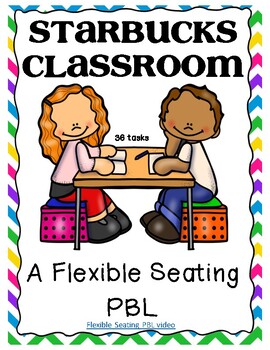Starbucks Classroom, A Flexible Seating PBL- 36 Tasks
- PDF
Description
Project Snapshot
Title: Starbucks Classroom
Grade Levels: 3rd-8th grades (Can be adapted for any age)
Type of Project: Design Challenge/Problem solving
Context: Our classroom needs help! We have some very uncomfortable chairs that need to be redesigned. We also need a more inviting space where students can focus better. We also need flexible seating options to fit all physical needs.
Learning Outcomes:
Research Strategies- pulling information and ideas from researching the best solution. Writing a quality interview/ data collection type question to gain information from others. Collaboration, communication and problem solving, Measurement- inch, foot, area, perimeter….. Safety- using a hammer, staple gun, glue gun…….Reading and informational text using text features and close reading. Demonstrate and describe processes used in developing, evaluating and improving on structures that will meet human needs with a margin of safety. Ongoing reflection through student journaling.
Driving Question: How can we create flexible seating options to maximize comfort to improve learning and focus? How can you, as a budding furniture designer, design and build a piece of furniture for students that will enhance and promote learning and comfort at the same time? How can we make flexible seating accessible for all physical needs?
Tangible Outcomes: Flexible seats for the classroom, information fliers for each type of flexible seat, flexible seating survey and interview questions, rules/procedure posters/cards for each flexible seat station.
Adult/World Connections: Meet with construction experts both in house and within the community with help constructing the actual seats, interview teachers of flexible seating classrooms. Work with the occupational therapist to design a floor seat for a student. Work with high school construction class and our adults with special needs program to help create the seats.
Tasks
1. The Why and The What
2. Research Jot Notes
3. Research Summary
4. Interview Question Stems
5. Digital Survey
6. Collect Data
7. Create Interview Questions
8. Classroom Visit Field Trip
9. Rate different options
10. Classroom Visit Look Fors
11. Analyze Data
12. Data Summary
13. Narrow Your Choices
14. Classroom Measurements
15. Explain Your Thinking
16. Conduct Research
17. Persuade
18. Persuade Your Teacher
19. Student Visions
20. Classroom Vision
21. Map It Out
22. Fundraising, Donations & Materials Needed
23. Donation Script
24. Rate Each Option
25. Flexible Seating Rules
26. Story Problems
27. Plan & Design
28. Define Challenge
29. Brainstorm
30. Design
31. Prototyping
32. Share Best Design/Feedback
33. Suggested DIY projects
34. Reflect
35. Present
36. Thank Yous
Starbucks Classroom Flexible Seating PBL Promo Video- This is a summary of this project with a middle school special needs classroom.
**Leave feedback and receive TPT credit! Did you know that you can build up TPT credit by leaving feedback on our products? You can submit feedback at the time of purchase or go to My Purchases for a list of what you have bought in the past. Next to each title is a Leave Feedback button. Click and leave a rating and comment to receive the credit. Go to TPT Credits to learn how to redeem your credits on future purchases!**
Happy Teaching:)
Druvenga's Pride





